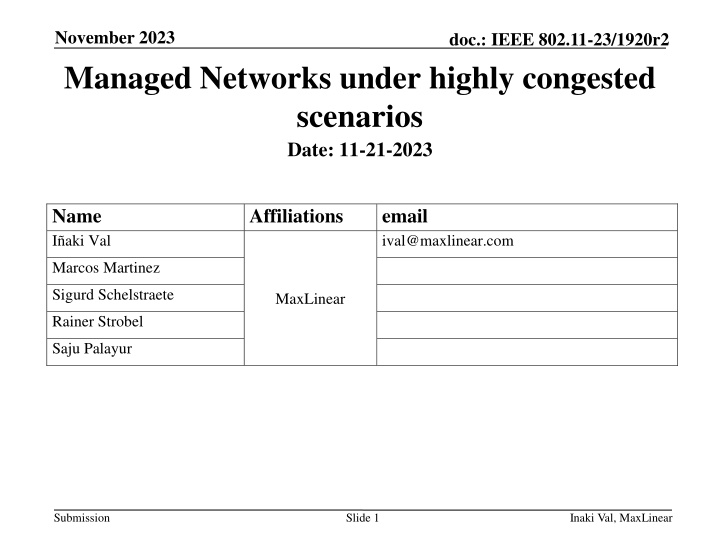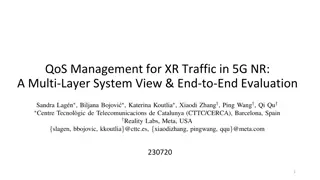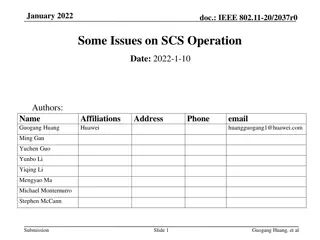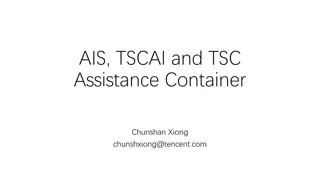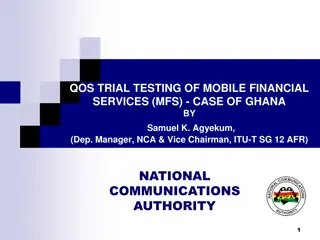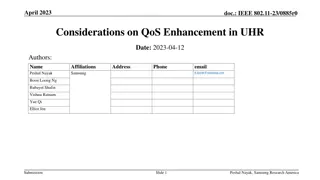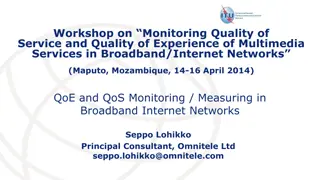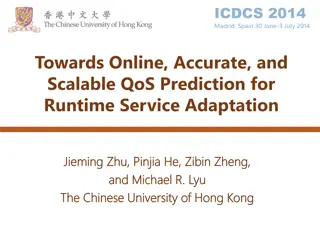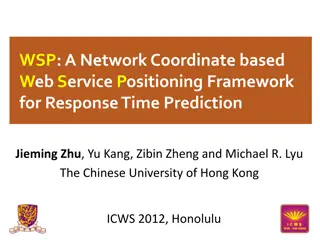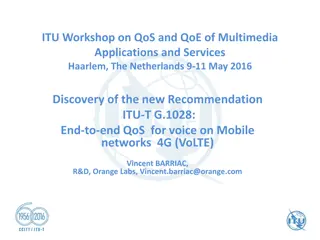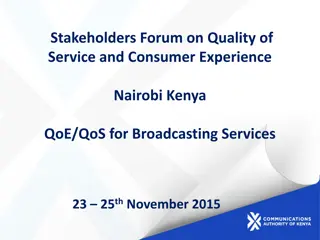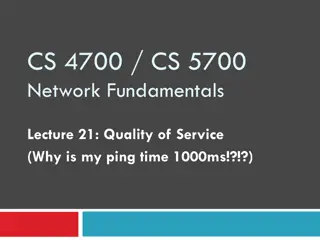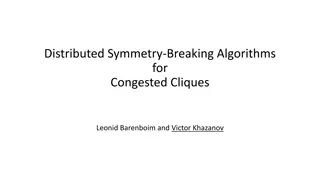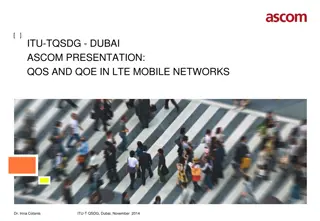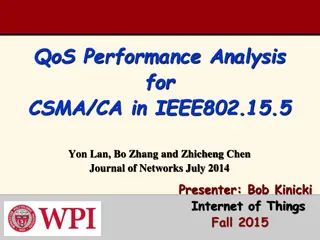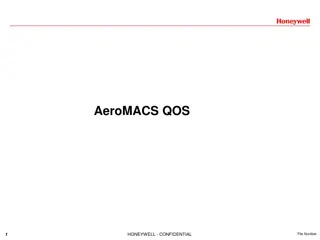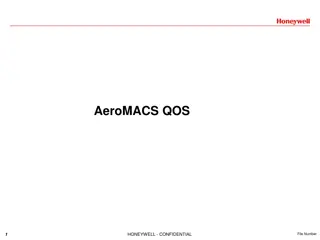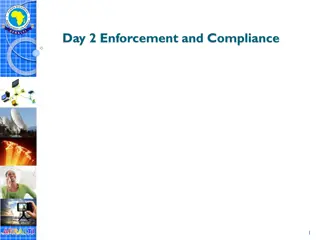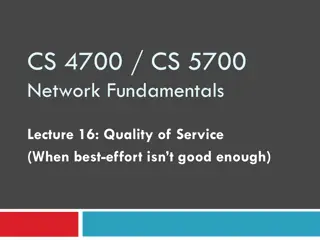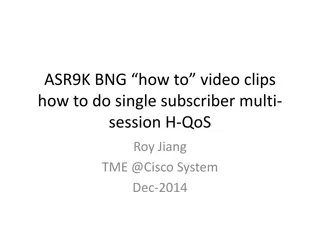Managing QoS in Highly Congested Networks
This document discusses challenges faced in managing Quality of Service (QoS) for network traffic under highly congested scenarios and proposes an AP-centric approach for improving QoS requirements. It highlights issues related to congestion, latency, and throughput in wireless networks and suggests strategies for addressing these concerns.
Uploaded on Apr 04, 2025 | 1 Views
Download Presentation

Please find below an Image/Link to download the presentation.
The content on the website is provided AS IS for your information and personal use only. It may not be sold, licensed, or shared on other websites without obtaining consent from the author.If you encounter any issues during the download, it is possible that the publisher has removed the file from their server.
You are allowed to download the files provided on this website for personal or commercial use, subject to the condition that they are used lawfully. All files are the property of their respective owners.
The content on the website is provided AS IS for your information and personal use only. It may not be sold, licensed, or shared on other websites without obtaining consent from the author.
E N D
Presentation Transcript
November 2023 Managed Networks under highly congested scenarios Date: 11-21-2023 doc.: IEEE 802.11-23/1920r2 Name I aki Val Affiliations email ival@maxlinear.com Marcos Martinez Sigurd Schelstraete MaxLinear Rainer Strobel Saju Palayur Submission Slide 1 Inaki Val, MaxLinear
November 2023 doc.: IEEE 802.11-23/1920r2 Goals Identify the current problems for QoS traffic under highly congested scenarios Discuss an approach based on the AP centric architecture or managed networks Submission Slide 2 Inaki Val, MaxLinear
November 2023 doc.: IEEE 802.11-23/1920r2 Introduction 802.11bn targets the improvement of packet delivery by reducing the transmission latency and enhancing network reliability [1] Applications and use cases with QoS-related requirements (e.g., bounded latency and reliability) have been growing in recent times [2] The critical QoS services can be mainly characterized by periodic traffic patterns, and strict timing requirements for data exchange [2, 3] Relying on maximizing throughput is not tenable in the long term as a sole requirement for correct QoS service operation QoS services must coexist with non-QoS services within the same BSS Submission Slide 3 Inaki Val, MaxLinear
November 2023 doc.: IEEE 802.11-23/1920r2 Problem Statement (1/2) The wireless scenarios are getting more congested due to the increase of connected high-performance Wi-Fi devices, competing for the wireless medium. It has been shown that as congestion increases, and under contention-based congestion management, aggregated throughput gets saturated, and the latency is highly affected [4, 5] This affects services whose QoS requirements are critical for a correct operation (reliability, latency, throughput) Throughput (Non Control) Throughput (DCF) Latency (DCF) Throughput Latency Network Load Mild Congestion Congestion Submission Slide 4 Inaki Val, MaxLinear
November 2023 doc.: IEEE 802.11-23/1920r2 Problem Statement (2/2) Under congested network scenarios, the AP competes against all the non-AP STAs The AP may gain efficiency and reduce latency by using MU trigger- based tools (i.e., TUA) as opposed to letting clients contend When EDCA admission control (i.e., TSPEC, SCS) is employed, it regulates the QoS traffic on its own BSS, but it does not consider the EDCA admitted traffic on an OBSS Submission Slide 5 Inaki Val, MaxLinear
November 2023 doc.: IEEE 802.11-23/1920r2 Managed Network One approach to address the issues mentioned on previous slides is to centralize and control the channel access from the AP AP-centric scheduled operations for controlling the QoS requirements Provide higher priority access to the AP for QoS transactions Establish QoS scheduling coordination mechanisms between OBSS APs DCF/EDCA mechanism must be preserved for coexistence with non-QoS services and legacy devices Submission Slide 6 Inaki Val, MaxLinear
November 2023 doc.: IEEE 802.11-23/1920r2 Existing Enabling Features Existing 802.11 features may help building an AP centric managed network SCS/MSCS Request resources for QoS traffic flows WFA QoS Management (DSCP Policy and QoS Mapping) Trigger-based access Control over UL/P2P access managed by the AP, increasing the efficiency (i.e., TUA, MU EDCA, TXS) Restricted TWT Plan which STAs will be awakened within a time window and guarantee channel availability for those STAs BSS color Identification of BSS networks BSRP STA polling to know their transmission buffer status EDCA for legacy clients Proper coordination and application of these features can already result in a more managed network Submission Slide 7 Inaki Val, MaxLinear
November 2023 doc.: IEEE 802.11-23/1920r2 Current Features Limitations Existing features offer a starting point, but there are gaps: APs struggle to access the channel when there are many clients contending at the same time, which causes difficulties in scheduling the network There exist features for adapting STA s EDCA parameters, but it solves the problem only partially The QoS management is limited to its own BSS How to guarantee QoS in presence of OBSS There are no coordination mechanisms to facilitate the cooperation between APs, covering the OBSS and ESS cases Previous 802.11 amendments have defined mechanisms in these areas HCCA, OBSS management (Channel selection, QLoad reports, HCCA advertisement), No market traction Submission Slide 8 Inaki Val, MaxLinear
November 2023 doc.: IEEE 802.11-23/1920r2 Addressing the gaps in UHR Several UHR proposals may further enable the concept of managed networks Optimized Scheduled TXOP [6] Pre-planned DL/UL QoS scheduling with persistence capability for periodic traffic patterns, controlling the QoS and latency Multi-AP C-TDMA / C-rTWT [7, 8, 9 , 10] Coordination of AP operations, avoiding collision, and protecting all the QoS TXOPs CSMA enhancements [11] Enhancements to regular EDCA allowing prioritized access P2P groups managed by the AP [12] Submission Slide 9 Inaki Val, MaxLinear
November 2023 doc.: IEEE 802.11-23/1920r2 Main Requirements Capability of AP-scheduled DL/UL/P2P QoS transactions, while guaranteeing latency and requested QoS requirements under highly congested scenario Provide legacy EDCA availability during the rest of the time Priority access for the AP during QoS accesses Silencing EDCA mechanism of network STAs to not disturb the QoS scheduled transfers Capability of coordinating the QoS scheduled accesses between APs, using proposed multi-AP mechanisms (e.g., Coordinated TDMA) Capability of quantifying the traffic load metrics of each BSS and sharing these reports for coordinating the use of common spectral resources, while maintaining the fairness in the assignment Capability of announcing and time synchronizing BSS operations to facilitate the coordination with other BSSs (OBSS or ESS) Submission Slide 10 Inaki Val, MaxLinear
November 2023 doc.: IEEE 802.11-23/1920r2 Conclusion We have discussed QoS requirements under highly congested scenarios and current/future traffic applications We believe there is a need for an operation mode based on AP-centric network access and control to address these scenarios Submission Slide 11 Inaki Val, MaxLinear
November 2023 doc.: IEEE 802.11-23/1920r2 Straw Poll Do you support enabling a mode of operation where channel access and operation for DL/UL/P2P are more centrally controlled by the AP? Y/N/A Submission Slide 12 Inaki Val, MaxLinear
November 2023 doc.: IEEE 802.11-23/1920r2 References [1] IEEE 802.11-23/0028r6, UHR PAR discussion [2] Inaki Val and et al. (MaxLinear), High Criticality Use Cases and Requirements , 23/1522r0, September 2023. [3] Oliver Holland and et al. Low Latency Communication White Paper , P802.24-23-0010r4, July 2023. [4] Tongxin Shu and et al. (Huawei), Requirements of Low Latency in UHR , 22/1519r0, September 2022. [5] R. Costa and et al., "Limitations of the IEEE 802.11 DCF, PCF, EDCA and HCCA to handle real-time traffic," 2015 IEEE 13th International Conference on Industrial Informatics (INDIN), Cambridge, UK, 2015, pp. 931-936, doi: 10.1109/INDIN.2015.7281860. [6] Dmitry Akhmetov and et al. (Intel), Medium efficient scheduled channel access in next generation 802.11 , 23/0936r0, July 2023. [7] Dibakar Das and et al. (Intel), C-TDMA procedure in UHR , 23/0261r0, January 2023. [8] Yanjun Sun and et al. (Qualcomm), Follow-up on Coordinated TDMA (C-TDMA) , 23/0739r1, July 2023. [9] Laurent Cariou and et al. (Intel), rTWT for Multi-AP , 23/0297r0, April 2023. [10] Abdel Karim Ajami and et al. (Qualcomm), Coordination of R-TWT for Multi-AP Deployment , 23/0226r2, July 2023. [11] Laurent Cariou and et al. (Intel), Low latency channel access , 23/1065r0, July 2023. [12] Rubayet Shafin and et al., P2P Resource Management , 23/1929r0, November 2023. Submission Slide 13 Inaki Val, MaxLinear
